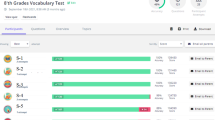Abstract
This study examined a group of English language learners’ use and evaluation of digital videos as a form of computer assisted language learning (CALL) material, as they were engaged to complete a video-based vocabulary learning task using a CALL system. The results indicated that the students were able to watch the assigned video clips for task completion with reasonable time and effort, without any major learning difficulties. It was also found that the top three most frequently used functionalities of the CALL system that enabled learner-content interaction were video subtitles, followed by the built-in dictionary, and adjustable playback speed. On the whole, the students considered the way that the video material was integrated in the vocabulary learning task was facilitative and capable of enhancing their English learning experiences, indicating the overall appropriateness of such video use.
Access this chapter
Tax calculation will be finalised at checkout
Purchases are for personal use only
Similar content being viewed by others
References
Warschauer, M.: Computer-assisted language learning: An Introduction. In: Fotos, S. (ed.) Multimedia Language Teaching, pp. 3–20. Logos International, Tokyo (1996)
Stockwell, G.: A review of technology choice for teaching language skills and areas in the CALL literature. ReCALL 19(2), 105–120 (2007)
Kayaoglu, M.N., Dag Akbas, R., Ozturk, Z.: A small scale experimental study: Using animations to learn vocabulary. Turk. Online J. Educ. Technol. 10(2), 24–30 (2011)
Lin, C.C.: Learning action verbs with animation. JALT CALL J. 5(3), 23–40 (2009)
Lin, C.C., Tseng, Y.F.: Videos and animations for vocabulary learning: A study on difficult words. Turk. Online J. Educ. Technol. 11(4), 346–355 (2012)
Samur, Y.: Redundancy effect on retention of vocabulary words using multimedia presentation. Br. J. Educ. Technol. 43(6), 166–170 (2012)
Farshi, N., Mohammadi, Z.: Use of podcasts in effective teaching of vocabulary: Learners’ attitudes, motivations, and limitations. Theory Pract. Lang. Stud. 3(8), 1381–1386 (2013)
Putman, S.M., Kingsley, T.: The atoms family: Using podcasts to enhance the development of science vocabulary. Read. Teach. 63(2), 100–108 (2009)
Lin, L.F.: English learners’ incidental vocabulary acquisition in the video-based CALL program. Asian EFL J. 12(4), 51–66 (2010)
Naraghizadeh, M., Barimani, S.: The effect of CALL on the vocabulary learning of Iranian EFL learners. J. Acad. Appl. Stud. 3(8), 1–12 (2013)
Karakaş, A., Sariçoban, A.: The impact of watching subtitled animated cartoons on incidental vocabulary learning of ELT students. Teach. Engl. Technol. 12(4), 3–15 (2012)
Yuksel, D., Tanriverdi, B.: Effects of watching captioned movie clip on vocabulary development of EFL learners. Turk. Online J. Educ. Technol. 8(2), 48–54 (2009)
Giannakos, M.N.: Exploring the research on video learning: A review of the literature. Br. J. Educ. Technol. 44(6), 191–195 (2013)
Goldstein, B., Driver, P.: Language Learning with Digital Video. Cambridge University Press, Cambridge (2014)
Mayer, R.E.: Applying the science of learning: Evidence-based principles for the design of multimedia instruction. Am. Psychol. 63(8), 760–769 (2008)
Mayer, R.E., Moreno, R.: Nine ways to reduce cognitive load in multimedia learning. Educ. Psychol. 38(1), 43–52 (2003)
Mayer, R.E.: Multimedia Learning. Cambridge University Press, New York (2009)
Mayer, R.E., Moreno, R.: Aids to computer-based multimedia learning. Learn. Instr. 12(1), 107–119 (2002)
Jones, L.C.: Supporting listening comprehension and vocabulary acquisition with multimedia annotations: The students’ voice. CALICO J. 21(1), 41–65 (2003)
Mayer, R.E., Moreno, R.: Animation as an aid to multimedia learning. Educ. Psychol. Rev. 14(1), 87–99 (2002)
Clark, R.C., Mayer, R.E.: E-learning and the Science of Instruction: Proven Guidelines for Consumers and Designers of Multimedia Learning. Pfeiffer, San Francisco (2011)
Mayer, R.E.: Applying the science of learning to medical education. Med. Educ. 44(6), 543–549 (2010)
Canning-Wilson, C.: Practical aspects of using video in the foreign language classroom. Internet TESL J. 6(11) (2000). http://iteslj.org/Articles/Canning-Video.html
Chapelle, C.A.: Computer Applications in Second Language Acquisition. Cambridge University Press, Cambridge (2001)
King, J.: Using DVD feature films in the EFL classroom. Comput. Assist. Lang. Learn. 15(5), 509–523 (2002)
Frumuselu, A.D., De Maeyer, S., Donche, V., del Mar Gutiérrez Colon Plana, M.: Television series inside the EFL classroom: Bridging the gap between teaching and learning informal language through subtitles. Linguist. Educ. 32, 107–117 (2015)
Liu, T.C., Lin, P.H.: What comes with technological convenience? Exploring the behaviors and performances of learning with computer-mediated dictionaries. Comput. Hum. Behav. 27(1), 373–383 (2011)
Levy, M., Steel, C.: Language learner perspectives on the functionality and use of electronic language dictionaries. ReCALL 27(2), 177–196 (2015)
Chen, H.J.H.: Developing and evaluating SynctoLearn, a fully automatic video and transcript synchronization tool for EFL learners. Comput. Assist. Lang. Learn. 24(2), 117–130 (2011)
Huang, P., Hwang, Y.: An exploration of EFL learners’ anxiety and E-learning environments. J. Lang. Teach. Res. 4(1), 27–35 (2013)
Jung, R., Lee, C.H.: Using Internet video clips for university students’ vocabulary development in blended learning. Multimedia Assist. Lang. Learn. 16(4), 67–96 (2013)
Tschirner, E.: Language acquisition in the classroom: The role of digital video. Comput. Assist. Lang. Learn. 14(3–4), 305–319 (2001)
Author information
Authors and Affiliations
Corresponding author
Editor information
Editors and Affiliations
Rights and permissions
Copyright information
© 2017 Springer International Publishing AG
About this paper
Cite this paper
Hung, HT., Lu, YF., Yeh, HC. (2017). Investigating Students’ Use and Evaluation of Video as a Form of Computer Assisted Language Learning Material. In: Wu, TT., Gennari, R., Huang, YM., Xie, H., Cao, Y. (eds) Emerging Technologies for Education. SETE 2016. Lecture Notes in Computer Science(), vol 10108. Springer, Cham. https://doi.org/10.1007/978-3-319-52836-6_24
Download citation
DOI: https://doi.org/10.1007/978-3-319-52836-6_24
Published:
Publisher Name: Springer, Cham
Print ISBN: 978-3-319-52835-9
Online ISBN: 978-3-319-52836-6
eBook Packages: Computer ScienceComputer Science (R0)




